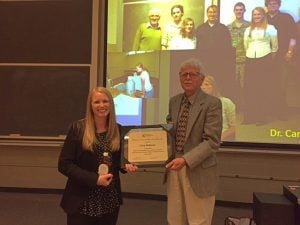 Our best wishes go to our office assistant, Sherry Andersen, as she leaves us to pursue new adventures in warmer climates.
Our best wishes go to our office assistant, Sherry Andersen, as she leaves us to pursue new adventures in warmer climates.
Good luck, Sherry!
 Our best wishes go to our office assistant, Sherry Andersen, as she leaves us to pursue new adventures in warmer climates.
Our best wishes go to our office assistant, Sherry Andersen, as she leaves us to pursue new adventures in warmer climates.
Good luck, Sherry!

Greg Odegard (MEEM) is the principal investigator on a project that has received a $1,000,000 research and development grant from the National Aeronautics and Space Administration. Ravi Pandey (Physics), Julia King (MEEM) and Trisha Sain (MEEM) are Co-Pis on the project titled “Institute for Ultra-Strong Composites by Computational Design (US-COMP).”
This is the first year of a five-year project potential totaling $14,999,995.
 Bo Zhang (2015), currently a research scientist at the National Institute of Aerospace in Hampton, VA, and co-authors published a paper, “Ten-year chemical signatures associated with long-range transport observed in the free tropophere over the central North Atlantic” in Elementa Science of the Anthropocene Journal.
Bo Zhang (2015), currently a research scientist at the National Institute of Aerospace in Hampton, VA, and co-authors published a paper, “Ten-year chemical signatures associated with long-range transport observed in the free tropophere over the central North Atlantic” in Elementa Science of the Anthropocene Journal.
Ten years of observations of trace gases at Pico Mountain Observatory (PMO), a free troposphere site in the central North Atlantic, were classified by transport pattern using the Lagrangian particle dispersion model FLEXPART.
The classification enabled identification of trace gas mixing ratios associated with background air and long-range transport of continental emissions, which were defined as chemical signatures. Comparison between the chemical signatures revealed the impacts of natural and anthropogenic sources, as well as chemical and physical processes during long transport, on air composition in the remote North Atlantic.

One million miles from Earth, a NASA camera is capturing unexpected flashes of light reflecting off our planet, and Alex Kostinski has helped identify them as ice particles high in the atmosphere. NASA, Health Medicine Net and Astrobiology Web have published news stories about the phenomena and the research.
Scientific American and Nature magazine reported on Kostinski’s research that helped NASA solve the mystery of flashes of light appearing over land, which turned out to be ice crystals high in the atmosphere. See the full story here.
Physics and mathematics major Crystal Massoglia was named the 2017 Physics Department Scholar. Congratulations, Crystal!
Arin graduated from our physics department with a bachelors in the year 2012, and went on to acquire a PhD. from the University of Colorado Boulder in Atmospheric and Oceanic Science. He’d like to thank all the faculty at Michigan Tech for their support during his undergrad years.
 Dr. Jacek Borysow presented Dr. Carly Robinson with the first Henes Center for Quantum Phenomena Distinguished Alumna Award. Dr. Robinson graduated with a BS in Physics from Michigan Tech in 2007, received her PhD from the University of Colorado, and is currently a Senior Product Strategist/Science Advisor with the U.S. Department of Energy.
Dr. Jacek Borysow presented Dr. Carly Robinson with the first Henes Center for Quantum Phenomena Distinguished Alumna Award. Dr. Robinson graduated with a BS in Physics from Michigan Tech in 2007, received her PhD from the University of Colorado, and is currently a Senior Product Strategist/Science Advisor with the U.S. Department of Energy.
Dr. Carly Robinson, a 2007 alumna of the physics department, awarded the 2017 Ian W. Shepherd award jointly to Ben Manning (left) and Kelci Mohrman (right). Congratulations, Kelci and Ben!
At the colloquium, seniors presented their research. From left to right, (standing) Dr. Will Cantrell, Kelci Mohrman, Floyd Johnson, Colin Sheidler, Nick Videtich, David Russell, Michael Foetisch, Dr. Jacek Borysow. (kneeling) Austin Hermann, Parker Schimler, Ben Manning, Dr. Carly Robinson.
 Kelci Mohrman received honorable mention from the National Science Foundation’s Graduate Research Fellowship Program (NSF-GRFP), one of the oldest and most competitive programs in the nation.
Kelci Mohrman received honorable mention from the National Science Foundation’s Graduate Research Fellowship Program (NSF-GRFP), one of the oldest and most competitive programs in the nation.
Pushpalatha Murthy, dean of Michigan Tech’s Graduate School says, “Being a recipient of the Graduate Research Fellowship or Honorable Mention status in this very prestigious competition speaks to the high caliber of our students and the dedication they have for both intellectual pursuits and serving society. The NSF-GRFP is unique in that it emphasizes commitment to both intellectual inquiry and service to society and are looking to support individuals who have the potential to be high achieving scientists and engineers as well as have a broader impact on society. These awards are a well-deserved recognition of the superior accomplishments of our students and the quality and dedication of Michigan Tech faculty, staff and programs. Crafting a winning proposal is a lot of effort and I want to congratulate the students for their accomplishments and thank the dedication and passion of the faculty and staff who helped them. I look forward to great contributions for our students.”
THE NSF Graduate Research Fellowship Program recognizes and supports outstanding graduate students in NSF-supported science, technology, engineering and mathematics disciplines who are pursing research-based master’s and doctoral degrees at accredited US institutions.
Mohrman recently participated in the Undergraduate Research Symposium.
Left: Kevin Waters, Right: Shiva Bhandari
Congratulations to Kevin and Shiva for their outstanding achievements these past few months! Kevin has been awarded the Teaching Award for exhibiting his exceptional abilities as an instructor. Shiva has been awarded the Scholarship Award for demonstrating strong leadership and professionalism within the Physics Department. Be sure to congratulate Kevin and Shiva the next time you see them!